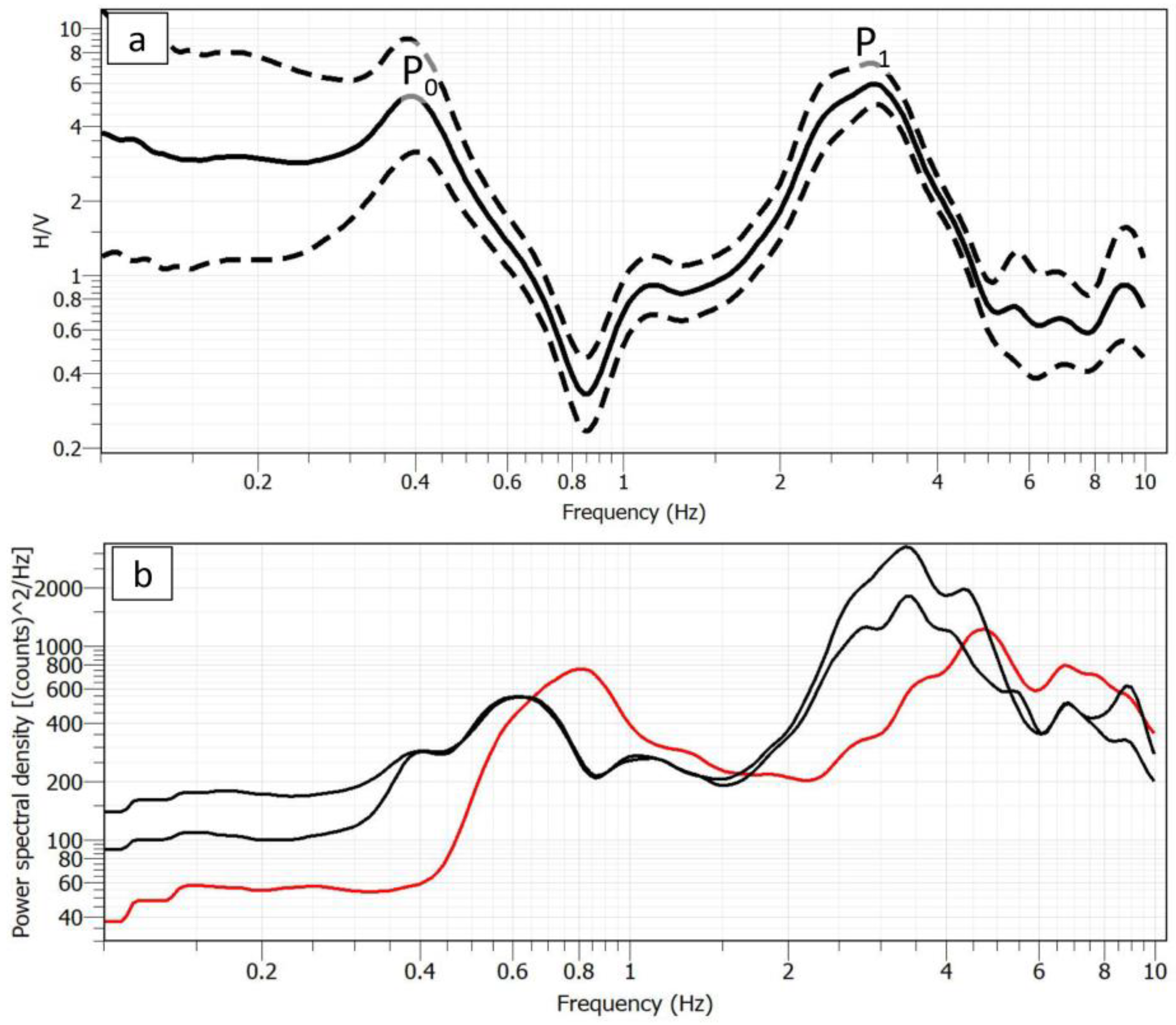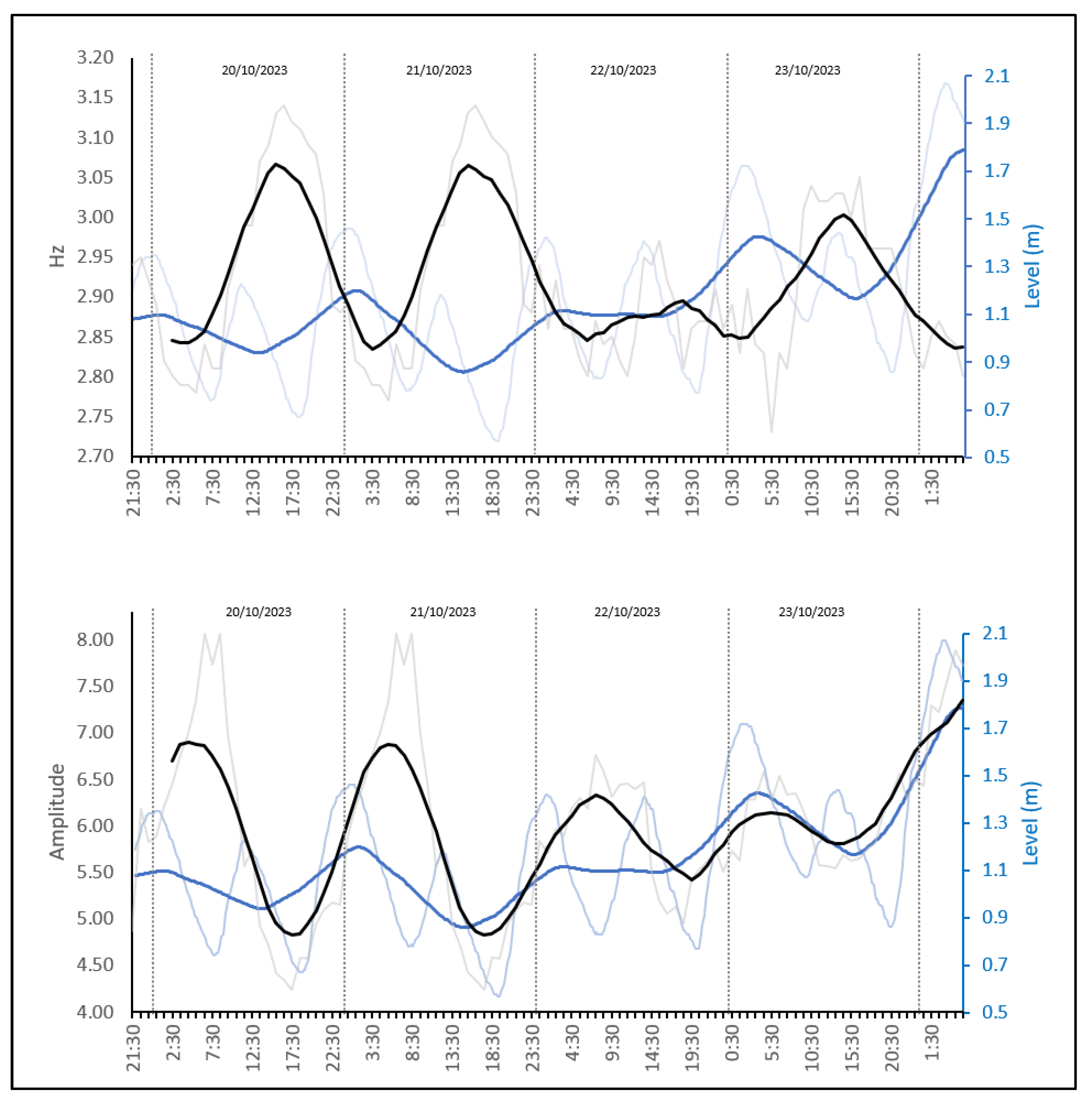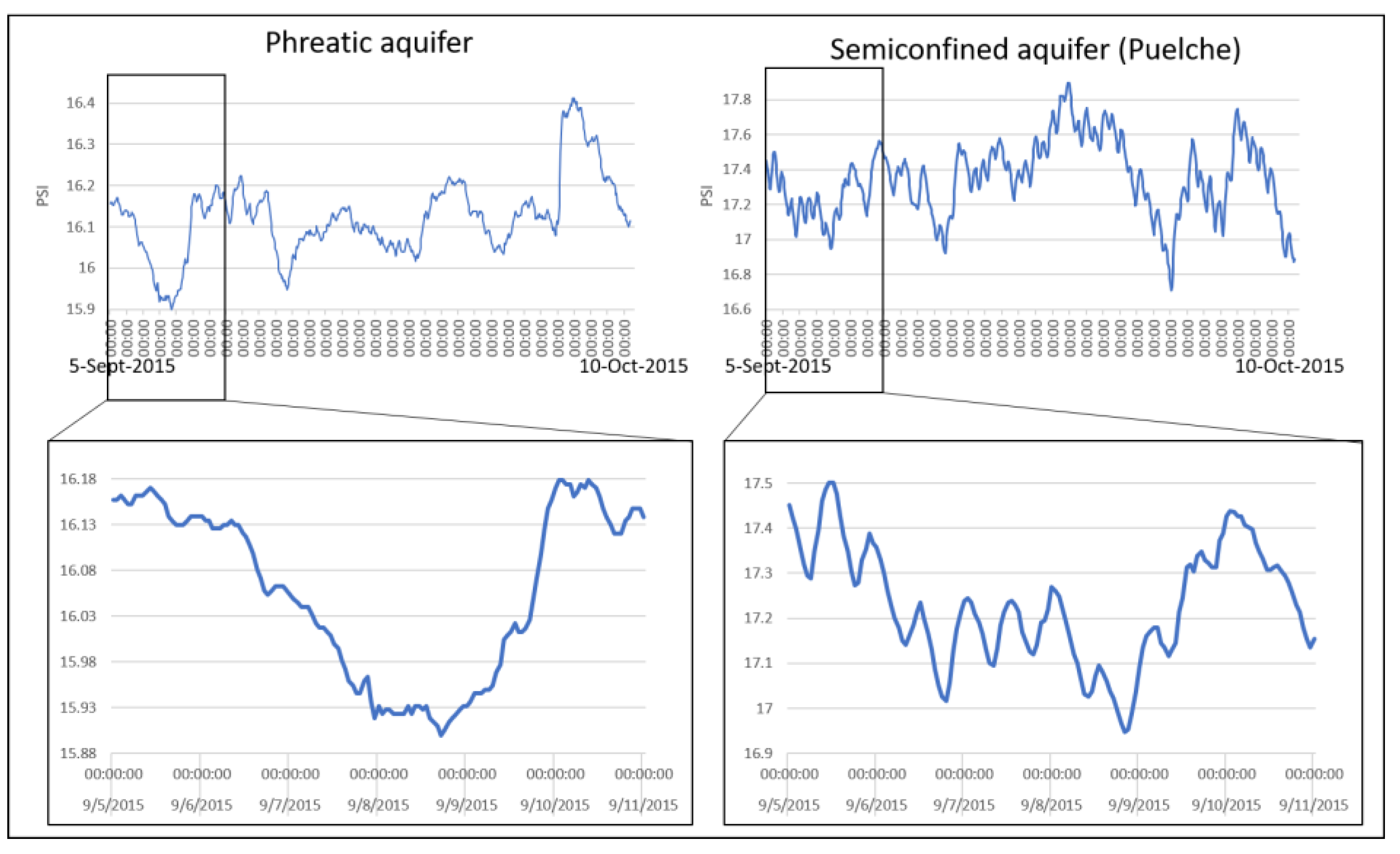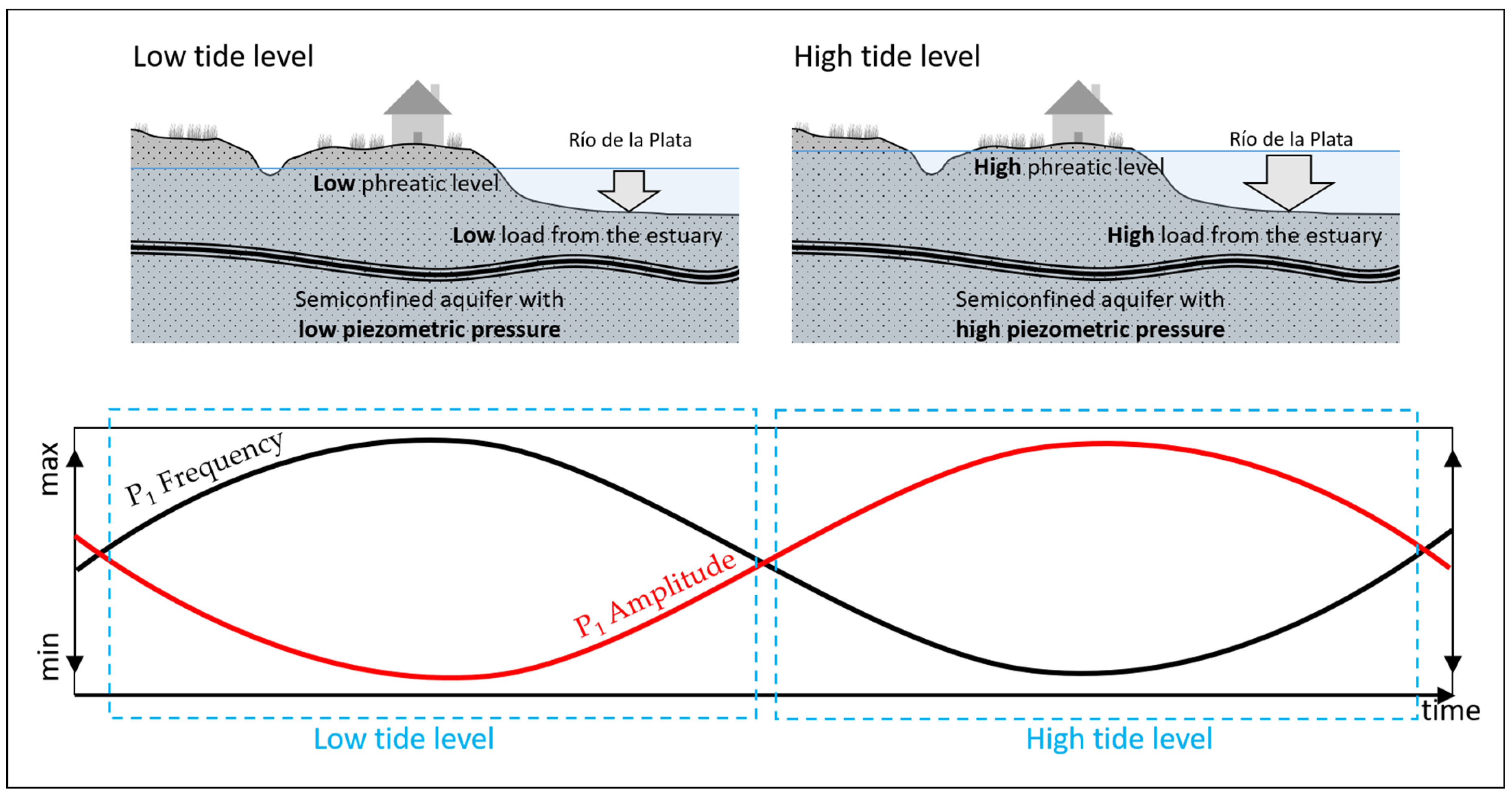A Seismic Monitoring Tool for Tidal-Forced Aquifer Level Changes in the Río de la Plata Coastal Plain, Argentina
Abstract
1. Introduction
2. The Río de la Plata Coastal Plain
3. Materials and Methods
4. Results
HVSR Time Variations
5. Discussion
6. Conclusions
Author Contributions
Funding
Institutional Review Board Statement
Informed Consent Statement
Data Availability Statement
Acknowledgments
Conflicts of Interest
References
- Liu, Y.; Huang, X.; Yang, H. An Integrated Approach to Investigate the Coupling Coordination between Urbanization and Flood Disasters in China. J. Clean. Prod. 2022, 375, 134191. [Google Scholar] [CrossRef]
- Malmir, M.; Javadi, S.; Moridi, A.; Randhir, T.; Saatsaz, M. Integrated Groundwater Management Using a Comprehensive Conceptual Framework. J. Hydrol. 2022, 605, 127363. [Google Scholar] [CrossRef]
- Nistor, M.M.; Rahardjo, H.; Satyanaga, A.; Hao, K.Z.; Xiaosheng, Q.; Sham, A.W.L. Investigation of Groundwater Table Distribution Using Borehole Piezometer Data Interpolation: Case Study of Singapore. Eng. Geol. 2020, 271, 105590. [Google Scholar] [CrossRef]
- Sendrós, A.; Urruela, A.; Himi, M.; Alonso, C.; Lovera, R.; Tapias, J.C.; Rivero, L.; Garcia-Artigas, R.; Casas, A. Characterization of a Shallow Coastal Aquifer in the Framework of a Subsurface Storage and Soil Aquifer Treatment Project Using Electrical Resistivity Tomography (Port de La Selva, Spain). Appl. Sci. 2021, 11, 2448. [Google Scholar] [CrossRef]
- Zhang, Z.; Weiping, W. Managing Aquifer Recharge with Multi-Source Water to Realize Sustainable Management of Groundwater Resources in Jinan, China. Environ. Sci. Pollut. Res. 2021, 28, 10872–10888. [Google Scholar] [CrossRef]
- Stehly, L.; Fry, B.; Campillo, M.; Shapiro, N.M.; Guilbert, J.; Boschi, L.; Giardini, D. Tomography of the Alpine Region from Observations of Seismic Ambient Noise. Geophys. J. Int. 2009, 178, 338–350. [Google Scholar] [CrossRef]
- Gu, N.; Gao, J.; Wang, B.; Lu, R.; Liu, B.; Xu, X.; Zhang, H. Ambient Noise Tomography of Local Shallow Structure of the Southern Segment of Tanlu Fault Zone at Suqian, Eastern China. Tectonophysics 2022, 825, 229234. [Google Scholar] [CrossRef]
- Scolaro, S.; Pino, P.; D’Amico, S.; Orecchio, B.; Presti, D.; Torre, A.; Totaro, C.; Farrugia, D.; Neri, G. Ambient Noise Measurements for Preliminary Microzoning Studies in the City of Messina, Sicily. Ann. Geophys. 2018, 61, 4. [Google Scholar] [CrossRef]
- Panzera, F.; Tortorici, G.; Romagnoli, G.; Marletta, G.; Catalano, S. Empirical Evidence of Orthogonal Relationship between Directional Site Effects and Fracture Azimuths in an Active Fault Zone: The Case of the Mt. Etna Lower Eastern Flank. Eng. Geol. 2020, 279, 105900. [Google Scholar] [CrossRef]
- Panzera, F.; Alber, J.; Imperatori, W.; Bergamo, P.; Fäh, D. Reconstructing a 3D Model from Geophysical Data for Local Amplification Modelling: The Study Case of the Upper Rhone Valley, Switzerland. Soil Dyn. Earthq. Eng. 2022, 155, 107163. [Google Scholar] [CrossRef]
- Rodríguez Tribaldos, V.; Ajo-Franklin, J.B. Aquifer Monitoring Using Ambient Seismic Noise Recorded with Distributed Acoustic Sensing (DAS) Deployed on Dark Fiber. J. Geophys. Res. Solid Earth 2021, 126, e2020JB021004. [Google Scholar] [CrossRef]
- Laudi, L.; Agius, M.R.; Galea, P.; D’Amico, S.; Schimmel, M. Monitoring of Groundwater in a Limestone Island Aquifer Using Ambient Seismic Noise. Water 2023, 15, 2523. [Google Scholar] [CrossRef]
- Barrière, J.; Krein, A.; Oth, A.; Schenkluhn, R. An Advanced Signal Processing Technique for Deriving Grain Size Information of Bedload Transport from Impact Plate Vibration Measurements. Earth Surf. Process. Landf. 2015, 40, 913–924. [Google Scholar] [CrossRef]
- Geay, T.; Belleudy, P.; Gervaise, C.; Habersack, H.; Aigner, J.; Kreisler, A.; Seitz, H.; Laronne, J.B. Passive Acoustic Monitoring of Bed Load Discharge in a Large Gravel Bed River. J. Geophys. Res. Earth Surf. 2017, 122, 528–545. [Google Scholar] [CrossRef]
- Eibl, E.P.S.; Bean, C.J.; Einarsson, B.; Pàlsson, F.; Vogfjörd, K.S. Seismic Ground Vibrations Give Advanced Early-Warning of Subglacial Floods. Nat. Commun. 2020, 11, 2504. [Google Scholar] [CrossRef] [PubMed]
- Preiswerk, L.E.; Walter, F. High-Frequency (>2 Hz) Ambient Seismic Noise on High-Melt Glaciers: Green’s Function Estimation and Source Characterization. J. Geophys. Res. Earth Surf. 2018, 123, 1667–1681. [Google Scholar] [CrossRef]
- Burjánek, J.; Gassner-Stamm, G.; Poggi, V.; Moore, J.R.; Fäh, D. Ambient Vibration Analysis of an Unstable Mountain Slope. Geophys. J. Int. 2010, 180, 820–828. [Google Scholar] [CrossRef]
- Galea, P.; D’Amico, S.; Farrugia, D. Dynamic Characteristics of an Active Coastal Spreading Area Using Ambient Noise Measurements—Anchor Bay, Malta. Geophys. J. Int. 2014, 199, 1166–1175. [Google Scholar] [CrossRef][Green Version]
- Panzera, F.; D’Amico, S.; Lotteri, A.; Galea, P.; Lombardo, G. Seismic Site Response of Unstable Steep Slope Using Noise Measurements: The Case Study of Xemxija Bay Area, Malta. Nat. Hazards Earth Syst. Sci. 2012, 12, 3421–3431. [Google Scholar] [CrossRef]
- Borzì, A.M.; Minio, V.; Cannavò, F.; Cavallaro, A.; D’Amico, S.; Gauci, A.; De Plaen, R.; Lecocq, T.; Nardone, G.; Orasi, A.; et al. Monitoring Extreme Meteo-Marine Events in the Mediterranean Area Using the Microseism (Medicane Apollo Case Study). Sci. Rep. 2022, 12, 21363. [Google Scholar] [CrossRef]
- Gerstoft, P.; Fehler, M.C.; Sabra, K.G. When Katrina Hit California. Geophys. Res. Lett. 2006, 33, L17308. [Google Scholar] [CrossRef]
- Nakamura, Y. A method for dynamic characteristics estimation of subsurface using microtremor on the ground surface. Railw. Tech. Res. Inst. Q. Rep. 1989, 30, 25–33. [Google Scholar]
- Nogoshi, M. On the Amplitude Characteristics of Microtremor, Part II. J. Seismol. Soc. Jpn. 1971, 24, 26–40. [Google Scholar]
- Cara, F.; Cultrera, G.; Azzara, R.M.; De Rubeis, V.; Di Giulio, G.; Giammarinaro, M.S.; Tosi, P.; Vallone, P.; Rovelli, A. Microtremor Measurements in the City of Palermo, Italy: Analysis of the Correlation between Local Geology and Damage. Bull. Seismol. Soc. Am. 2008, 98, 1354–1372. [Google Scholar] [CrossRef]
- Mucciarelli, M.; Gallipoli, M. A Critical Review of 10 Years of Microtremor HVSR Technique. Boll. Geofis. Teor. Appl. 2001, 42, 255–266. [Google Scholar]
- Panou, A.A.; Theodulidis, N.; Hatzidimitriou, P.; Stylianidis, K.; Papazachos, C.B. Ambient Noise Horizontal-to-Vertical Spectral Ratio in Site Effects Estimation and Correlation with Seismic Damage Distribution in Urban Environment: The Case of the City of Thessaloniki (Northern Greece). Soil Dyn. Earthq. Eng. 2005, 25, 261–274. [Google Scholar] [CrossRef]
- Panzera, F.; Bergamo, P.; Fäh, D. Canonical Correlation Analysis Based on Site-Response Proxies to Predict Site-Specific Amplification Functions in Switzerland. Bull. Seismol. Soc. Am. 2021, 111, 1905–1920. [Google Scholar] [CrossRef]
- Theodoulidis, N.; Cultrera, G.; De Rubeis, V.; Cara, F.; Panou, A.; Pagani, M.; Teves-Costa, P. Correlation between Damage Distribution and Ambient Noise H/V Spectral Ratio: The SESAME Project Results. Bull. Earthq. Eng. 2008, 6, 109–140. [Google Scholar] [CrossRef]
- Bonnefoy-Claudet, S.; Cornou, C.; Bard, P.-Y.; Cotton, F.; Moczo, P.; Kristek, J.; Fäh, D. H/V Ratio: A Tool for Site Effects Evaluation. Results from 1-D Noise Simulations. Geophys. J. Int. 2006, 167, 827–837. [Google Scholar] [CrossRef]
- Hobiger, M.; Bard, P.-Y.; Cornou, C.; Le Bihan, N. Single Station Determination of Rayleigh Wave Ellipticity by Using the Random Decrement Technique (RayDec). Geophys. Res. Lett. 2009, 36, L14303. [Google Scholar] [CrossRef]
- Becker, D.; Cristiano, L.; Peikert, J.; Kruse, T.; Dethof, F.; Hadziioannou, C.; Meier, T. Temporal Modulation of the Local Microseism in the North Sea. J. Geophys. Res. Solid Earth 2020, 125, e2020JB019770. [Google Scholar] [CrossRef]
- Benkaci, N.; Oubaiche, E.H.; Chatelain, J.-L.; Bensalem, R.; Benouar, D.; Abbes, K. Non-Stability and Non-Reproducibility of Ambient Vibration HVSR Peaks in Algiers (Algeria). J. Earthq. Eng. 2021, 25, 853–871. [Google Scholar] [CrossRef]
- La Rocca, M.; Chiappetta, G.D.; Gervasi, A.; Festa, R.L. Non-Stability of the Noise HVSR at Sites near or on Topographic Heights. Geophys. J. Int. 2020, 222, 2162–2171. [Google Scholar] [CrossRef]
- La Rocca, M.; Chiappetta, G.D. Day–Night Cycle of Seismic Noise HVSR and Comparison with Body Waves and T Waves. Geophys. J. Int. 2022, 231, 1535–1544. [Google Scholar] [CrossRef]
- Lontsi, A.M.; Hobiger, M.; Panzera, F.; Sánchez-Sesma, F.J.; Fäh, D. Seismic Characterization of Swiss Strong-Motion Borehole-Station Sites by Inversion of Full Microtremor Horizontal-to-Vertical Spectral Ratios [H/V(z, f)]. Bull. Seismol. Soc. Am. 2023, 113, 417–436. [Google Scholar] [CrossRef]
- Amalokwu, K.; Best, A.I.; Sothcott, J.; Chapman, M.; Minshull, T.; Li, X.-Y. Water Saturation Effects on Elastic Wave Attenuation in Porous Rocks with Aligned Fractures. Geophys. J. Int. 2014, 197, 943–947. [Google Scholar] [CrossRef]
- D’Hour, V.; Schimmel, M.; Do Nascimento, A.F.; Ferreira, J.M.; Lima Neto, H.C. Detection of Subtle Hydromechanical Medium Changes Caused By a Small-Magnitude Earthquake Swarm in NE Brazil. Pure Appl. Geophys. 2016, 173, 1097–1113. [Google Scholar] [CrossRef]
- Bergamo, P.; Donohue, S.; Gunn, D.A.; Dashwood, B.; Uhlemann, S.; Chambers, J.E.; Ward, D. Time-Lapse Monitoring of the Slopes of a Heritage Earthwork by Means of Near-Surface Seismic Techniques; European Association of Geoscientists & Engineers: Utrecht, The Netherlands, 2015; Volume 2015, pp. 1–5. [Google Scholar]
- Yu, H.; Hilterman, F.J. Shear Wave Sensitivity to Pore Pressure Prediction. In SEG Technical Program Expanded Abstracts 2013; SEG Technical Program Expanded Abstracts; Society of Exploration Geophysicists: Houston, TX, USA, 2013; pp. 600–604. [Google Scholar]
- Kula, D.; Olszewska, D.; Dobiński, W.; Glazer, M. Horizontal-to-Vertical Spectral Ratio Variability in the Presence of Permafrost. Geophys. J. Int. 2018, 214, 219–231. [Google Scholar] [CrossRef]
- Rigo, A.; Sokos, E.; Lefils, V.; Briole, P. Seasonal Variations in Amplitudes and Resonance Frequencies of the HVSR Amplification Peaks Linked to Groundwater. Geophys. J. Int. 2021, 226, 1–13. [Google Scholar] [CrossRef]
- Seivane, H.; García-Jerez, A.; Navarro, M.; Molina, L.; Navarro-Martínez, F. On the Use of the Microtremor HVSR for Tracking Velocity Changes: A Case Study in Campo de Dalías Basin (SE Spain). Geophys. J. Int. 2022, 230, 542–564. [Google Scholar] [CrossRef]
- Mianzan, H.; Lasta, C.; Acha, E.; Guerrero, R.; Macchi, G.; Bremec, C. The Río de La Plata Estuary, Argentina-Uruguay. In Coastal Marine Ecosystems of Latin America; Ecological Studies; Seeliger, U., Kjerfve, B., Eds.; Springer: Berlin/Heidelberg, Germany, 2001; pp. 185–204. ISBN 978-3-662-04482-7. [Google Scholar]
- Framiñan, M.B.; Etala, M.P.; Acha, E.M.; Guerrero, R.A.; Lasta, C.A.; Brown, O.B. Physical Characteristics and Processes of the Río de La Plata Estuary. In Estuaries of South America: Their Geomorphology and Dynamics; Environmental Science; Perillo, G.M.E., Piccolo, M.C., Pino-Quivira, M., Eds.; Springer: Berlin/Heidelberg, Germany, 1999; pp. 161–194. ISBN 978-3-642-60131-6. [Google Scholar]
- Guerrero, R.A.; Acha, E.M.; Framinan, M.B.; Lasta, C.A. Physical Oceanography of the Río de La Plata Estuary, Argentina. Cont. Shelf Res. 1997, 17, 727–742. [Google Scholar] [CrossRef]
- Cavallotto, J.L. Evolución Geomorfológica de la Llanura Costera Ubicada en el Margen sur del Río de la Plata. Ph.D. Thesis, Universidad Nacional de La Plata (UNLP), La Plata, Argentina, 1995. [Google Scholar]
- Fidalgo, F.; Martinez, O. Algunas Características Geomorfológicas Dentro Del Partido de La Plata, Provincia de Buenos Aires. Rev. Asoc. Geológica Argent. 1983, 38, 263–279. [Google Scholar]
- Fidalgo, F.; Colado, U.R.; De Francesco, F.O. Sobre ingresiones marinas cuaternarias en los partidos de casteli, chacomus y magdalena (pcia. de buenos aires). Buenos Aires Dep. Argent. Sci. Publ. 1973, 3, 227–240. [Google Scholar]
- Fucks, E.E.; D’Amico, G.; Pisano, M.F.; Nuccetelli, G. Evolución geomorfológica de la región del Gran La Plata y su relación con eventos catastróficos. Rev. Asoc. Geológica Argent. 2017, 74, 141–154. [Google Scholar]
- Santucci, L.; Carol, E.; Borzi, G.; García, M.G. Hydrogeochemical and Isotopic Signature of Surface and Groundwater in a Highly Industrialized Sector of the Rio de La Plata Coastal Plain (Argentina). Mar. Pollut. Bull. 2017, 120, 387–395. [Google Scholar] [CrossRef]
- Kruse, E.E.; Carol, E.S.; Mancuso, M.; Laurencena, P.C.; Deluchi, M.H.; Rojo, A. Recharge Assessment in an Urban Area: A Case Study of La Plata, Argentina. Hydrogeol. J. 2013, 21, 1091–1100. [Google Scholar] [CrossRef]
- Logan, W.S.; Nicholson, R.V. Origin of Dissolved Groundwater Sulphate in Coastal Plain Sediments of the Rio de La Plata, Eastern Argentina. Aquat. Geochem. 1997, 3, 305–328. [Google Scholar] [CrossRef]
- Carol, E.; Kruse, E.; Tejada, M. Surface Water and Groundwater Response to the Tide in Coastal Wetlands: Assessment of a Marsh in the Outer Río de La Plata Estuary, Argentina. J. Coast. Res. 2013, 165, 1098–1103. [Google Scholar] [CrossRef]
- Santucci, L.; Romina, S.; Eleonora, C.; Esteban, V.; Héctor, P. Using H, O, Rn Isotopes and Hydrometric Parameters to Assess the Surface Water-Groundwater Interaction in Coastal Wetlands Associated to the Marginal Forest of the Río de La Plata. Cont. Shelf Res. 2019, 186, 104–110. [Google Scholar] [CrossRef]
- Wathelet, M.; Chatelain, J.; Cornou, C.; Giulio, G.D.; Guillier, B.; Ohrnberger, M.; Savvaidis, A. Geopsy: A User-Friendly Open-Source Tool Set for Ambient Vibration Processing. Seismol. Res. Lett. 2020, 91, 1878–1889. [Google Scholar] [CrossRef]
- Leucci, G.; Persico, R.; De Giorgi, L.; Lazzari, M.; Colica, E.; Martino, S.; Iannucci, R.; Galone, L.; D’Amico, S. Stability Assessment and Geomorphological Evolution of Sea Natural Arches by Geophysical Measurement: The Case Study of Wied Il-Mielah Window (Gozo, Malta). Sustainability 2021, 13, 12538. [Google Scholar] [CrossRef]
- Vella, A.; Galea, P.; D’Amico, S. Site Frequency Response Characterisation of the Maltese Islands Based on Ambient Noise H/V Ratios. Eng. Geol. 2013, 163, 89–100. [Google Scholar] [CrossRef]
- Konno, K.; Ohmachi, T. Ground-Motion Characteristics Estimated from Spectral Ratio between Horizontal and Vertical Components of Microtremor. Bull. Seismol. Soc. Am. 1998, 88, 228–241. [Google Scholar] [CrossRef]
- Chandler, V.W.; Lively, R.S. Utility of the Horizontal-to-Vertical Spectral Ratio Passive Seismic Method for Estimating Thickness of Quaternary Sediments in Minnesota and Adjacent Parts of Wisconsin. Interpretation 2016, 4, SH71–SH90. [Google Scholar] [CrossRef]
- Galone, L.; D’Amico, S.; Colica, E.; Iregbeyen, P.; Galea, P.; Rivero, L.; Villani, F. Assessing Shallow Soft Deposits through Near-Surface Geophysics and UAV-SfM: Application in Pocket Beaches Environments. Remote Sens. 2024, 16, 40. [Google Scholar] [CrossRef]
- Molnar, S.; Cassidy, J.F.; Castellaro, S.; Cornou, C.; Crow, H.; Hunter, J.A.; Matsushima, S.; Sánchez-Sesma, F.J.; Yong, A. Application of Microtremor Horizontal-to-Vertical Spectral Ratio (MHVSR) Analysis for Site Characterization: State of the Art. Surv. Geophys. 2018, 39, 613–631. [Google Scholar] [CrossRef]
- Galone, L.; Colica, E.; D’Amico, S.; Cellone, F.; Carol, E.; Fucks, E.E. Progresses in European Earthquake Engineering and Seismology. In Proceedings of the Third European Conference on Earthquake Engineering and Seismology, Bucharest, Romania, 4–9 September 2022; pp. 4596–4600. [Google Scholar]
- Oubaiche, E.H.; Chatelain, J.-L.; Bouguern, A.; Bensalem, R.; Machane, D.; Hellel, M.; Khaldaoui, F.; Guillier, B. Experimental Relationship between Ambient Vibration H/V Peak Amplitude and Shear-Wave Velocity Contrast. Seismol. Res. Lett. 2012, 83, 1038–1046. [Google Scholar] [CrossRef]
- Clements, T.; Denolle, M.A. Tracking Groundwater Levels Using the Ambient Seismic Field. Geophys. Res. Lett. 2018, 45, 6459–6465. [Google Scholar] [CrossRef]
- Kim, D.; Lekic, V. Groundwater Variations From Autocorrelation and Receiver Functions. Geophys. Res. Lett. 2019, 46, 13722–13729. [Google Scholar] [CrossRef]
- Lecocq, T.; Longuevergne, L.; Pedersen, H.A.; Brenguier, F.; Stammler, K. Monitoring Ground Water Storage at Mesoscale Using Seismic Noise: 30 Years of Continuous Observation and Thermo-Elastic and Hydrological Modeling. Sci. Rep. 2017, 7, 14241. [Google Scholar] [CrossRef]
- Alcaraz, M.; Carrera, J.; Cuello, J.E.; Guarracino, L.; Vives, L. Determining Hydraulic Connectivity of the Coastal Aquifer System of La Plata River Estuary (Argentina) to the Ocean by Analysis of Aquifer Response to Low-Frequency Tidal Components. Hydrogeol. J. 2021, 29, 1587–1599. [Google Scholar] [CrossRef]
- Cuello, J.E.; Guarracino, L.; García Alcaraz, M.d.M.; Vives, L.S.; Carrera, J. Mechanical interaction between the Río de La Plata and the coastal aquifer system in the Northeast of the Province of Buenos Aires, Argentina. Boletín Geológico Min. 2022, 133, 227–243. [Google Scholar] [CrossRef]
- Guarracino, L.; Carrera, J.; Vázquez-Suñé, E. Analytical Study of Hydraulic and Mechanical Effects on Tide-Induced Head Fluctuation in a Coastal Aquifer System That Extends under the Sea. J. Hydrol. 2012, 450–451, 150–158. [Google Scholar] [CrossRef]
- Monachesi, L.B.; Guarracino, L. Exact and Approximate Analytical Solutions of Groundwater Response to Tidal Fluctuations in a Theoretical Inhomogeneous Coastal Confined Aquifer. Hydrogeol. J. 2011, 19, 1443–1449. [Google Scholar] [CrossRef]







Disclaimer/Publisher’s Note: The statements, opinions and data contained in all publications are solely those of the individual author(s) and contributor(s) and not of MDPI and/or the editor(s). MDPI and/or the editor(s) disclaim responsibility for any injury to people or property resulting from any ideas, methods, instructions or products referred to in the content. |
© 2024 by the authors. Licensee MDPI, Basel, Switzerland. This article is an open access article distributed under the terms and conditions of the Creative Commons Attribution (CC BY) license (https://creativecommons.org/licenses/by/4.0/).
Share and Cite
Galone, L.; Panzera, F.; Colica, E.; Fucks, E.; Carol, E.; Cellone, F.; Rivero, L.; Agius, M.R.; D’Amico, S. A Seismic Monitoring Tool for Tidal-Forced Aquifer Level Changes in the Río de la Plata Coastal Plain, Argentina. Sustainability 2024, 16, 1432. https://doi.org/10.3390/su16041432
Galone L, Panzera F, Colica E, Fucks E, Carol E, Cellone F, Rivero L, Agius MR, D’Amico S. A Seismic Monitoring Tool for Tidal-Forced Aquifer Level Changes in the Río de la Plata Coastal Plain, Argentina. Sustainability. 2024; 16(4):1432. https://doi.org/10.3390/su16041432
Chicago/Turabian StyleGalone, Luciano, Francesco Panzera, Emanuele Colica, Enrique Fucks, Eleonora Carol, Francisco Cellone, Lluís Rivero, Matthew R. Agius, and Sebastiano D’Amico. 2024. "A Seismic Monitoring Tool for Tidal-Forced Aquifer Level Changes in the Río de la Plata Coastal Plain, Argentina" Sustainability 16, no. 4: 1432. https://doi.org/10.3390/su16041432
APA StyleGalone, L., Panzera, F., Colica, E., Fucks, E., Carol, E., Cellone, F., Rivero, L., Agius, M. R., & D’Amico, S. (2024). A Seismic Monitoring Tool for Tidal-Forced Aquifer Level Changes in the Río de la Plata Coastal Plain, Argentina. Sustainability, 16(4), 1432. https://doi.org/10.3390/su16041432








